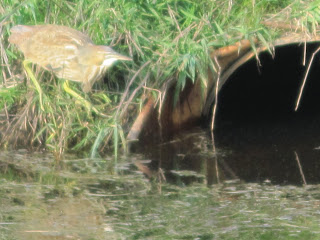Along the lower reaches of the Columbia River lies this wildlife refuge. The 5,218 acres of refuge contain a lush mixture of wetlands, grasslands, and forests of Douglas-fir and Oregon white oak. Lewis and Clarke came to this area first in November 5,1805 and observed a large Cathlapotle Indian village with 14 cedar plankhouses. Below is a replica of one of those homes which we saw yesterday while hiking in the Refuge.
The door was designed to be low and round to keep out enemies, supposedly representing the womb. A Chinook Indian painted the man on the door. The red side of his face represents his spirituality. He has only three ribs because that was one of the Cathlapotle Indian's favorite numbers. Lewis and Clark returned to this village in March 1806 and camped at a "butifull grassy place" about a mile upstream. I could not help but often think of these two men as we hiked the forests and walked along the lake located there.
We saw many patches of the Lily Avalanche wildflower, pictured below.
There was also a lot of the False Solomon's Seal. In one large patch of that plant the blue Camus flower also made its appearance.
After completing the hike in the woodland area of the Refuge we drove over to the River "S" Unit of the refuge on the lower Columbia River. This is a four-mile road through wetlands where there are a variety of migratory waterfowl and other wildlife. As we entered the area we espied this American Bittern staring intently into a drainage pipe. It was a long time that he stood here in this pose. We moved on.
We also saw one river otter swimming around, also a black-crowned night heron ,a white egret, cinnamon teal and mallard ducks. Canadian geese were everywhere, I had never seen so many of them before in one place. What an awesome sight when a large number of them would take flight at the same time!
.
Saturday, April 17, 2010
Subscribe to:
Post Comments (Atom)





No comments:
Post a Comment